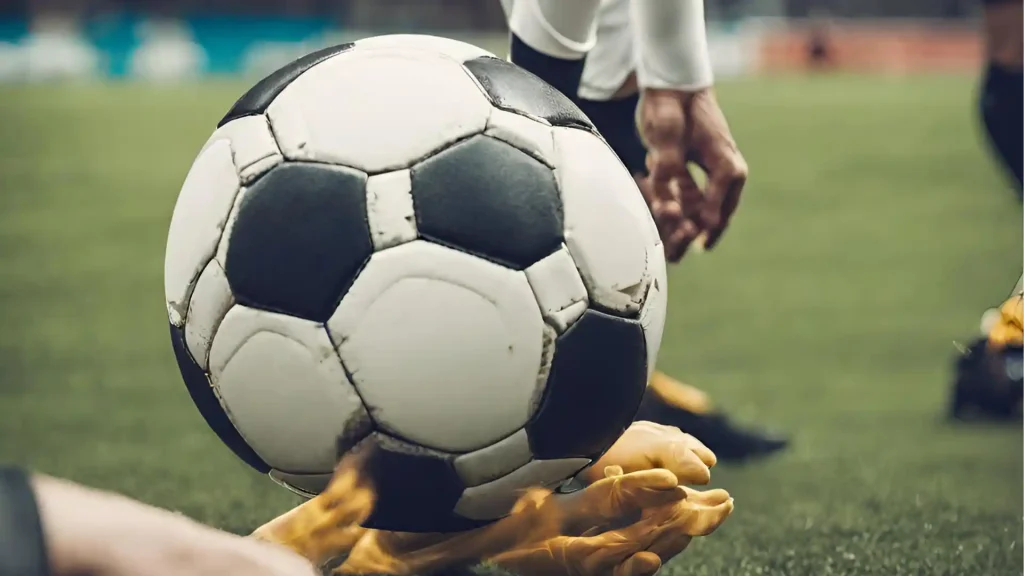
To improve catching skills, focus on hand positioning, enhance hand-eye coordination through tracking drills, strengthen hands, practice fingertip catches, work on reaction time, refine body positioning and balance, train in various conditions, incorporate one-handed drills, prioritize consistency, and commit to regular, purposeful practice.
Catching a football is a fundamental skill that every player on the gridiron needs to master. Whether you’re a wide receiver, tight end, or even a running back, the ability to catch the ball can make a significant difference in your performance and the success of your team.
In this comprehensive guide, we will delve into the various aspects of catching a football, from understanding the fundamentals to mastering advanced techniques.
The role of catching in football:
Catching a football isn’t just about showing off your mad skills and making jaw-dropping catches like a superhero. Understanding the role of catching in football is crucial as it directly contributes to offensive plays, scoring opportunities, and overall team success.
When everyone on the team can catch like a pro, it opens up a wide range of offensive options and keeps the opposing defense on their toes. So, mastering the art of catching isn’t just about personal glory – it’s about contributing to the success of the team.
Catching is like the glue that holds the offense together, and without it, your team might as well be playing with a deflated balloon. After all, you can’t score touchdowns or move the ball down the field if you can’t catch it in the first place.
The basic mechanics of catching a football:
Catching a football may appear to be a simple task, but there is more to it than that. It’s not as simple as throwing your hands up and hoping for the best. It entails a series of coordinated movements, including tracking the ball, positioning your body, and using proper hand placement, all while avoiding those pesky defenders. It’s like playing Twister but with a ball hurtling towards you at breakneck speed.
First, you need to watch the ball like a hawk, keeping your eyes locked on it until it safely lands in your hands. Next, you need to position your body correctly, using your feet and body alignment to create a solid foundation.
Finally, your hands need to be in the right place, with your fingers forming a secure and reliable grip. It’s like a delicate dance, but instead of a partner, you’re dancing with a pigskin.
To enhance your catching skill in football, let us learn step by step how to get better at catching a football
Step 1: Master the Basics of Hand Placement:
Your hands are the main actors in the catching performance, so it’s crucial to get their placement just right. Your fingers should be spread wide, ready to wrap around the ball like a loving embrace.
You want to catch the ball with your hands, not your body, so avoid turning your chest into a makeshift football magnet. And remember, a little finger strength goes a long way – squeeze those hands together like you’re trying to crush a soda can but with finesse and grace.
Ensure proper hand positioning by forming a diamond shape with your hands, thumbs, and index fingers touching, creating a secure pocket for the ball.
Step 2: Develop Hand-Eye Coordination:
Hand-eye coordination is a vital skill for catching a football too. It’s all about training your brain and body to work together seamlessly, so your hands can react to the ball’s trajectory without a moment’s hesitation.
If you feel like your hand-eye coordination is a bit lacking, don’t worry; there are ways to improve it. Practice drills that involve tracking moving objects, like tossing a tennis ball against a wall and catching it, can work wonders. You can also try playing other sports that require good hand-eye coordination, like ping pong or racquetball.
When it comes to catching, focus is key. You need to be in the zone, fully present and alert, ready to pounce on that ball like a hungry cheetah. One way to enhance your focus during catching drills is to eliminate distractions.
Practice tracking the ball from the moment it leaves the quarterback’s hands until it reaches yours, enhancing your hand-eye coordination and focus.
Step 3: Body Positioning and Finger-Tip Catching Technique:
When it comes to catching a football, your body needs to be more than just a haphazard collection of limbs. Proper body positioning is key to ensuring a successful catch. It’s all about getting your feet in the right position, turning your body towards the ball, and using your arms to create a nice little cradle for the incoming pigskin.
Emphasize catching the ball with your fingertips rather than your palms, allowing for better control, and grip, and minimizing the risk of drops.
The key is to stay flexible, like a yoga master, ready to contort your body into whatever position necessary to make that catch.
Step 4: Focus on Hand Strength and Flexibility:
Strengthening your hand muscles through targeted exercises is crucial for improving your ability in catching a football, enhancing grip strength, and minimizing the risk of drops.
Engage in hand-strengthening exercises such as grip squeezes and finger stretches to enhance flexibility and grip strength, for catching under various conditions.

Step 5: Improve Your Reaction Time:
Utilize reaction drills to enhance your response time, simulating game scenarios and training your body to react quickly to unpredictable ball trajectories.
Engage in drills that simulate game scenarios, challenging your ability to read the play quickly and react with precision, thereby refining your skills in catching a football under varying conditions and increasing your overall effectiveness on the field.
Step 6: Enhancing Catching Skills Through Practice:
To get better at catching a football, practice is essential. In this section, we’ll explore some essential catching drills for beginners, progressing to advanced drills, and incorporating game-like scenarios into your practice sessions.
If you’re just starting, start with basic catching drills to build a solid foundation. Begin with stationary catches, gradually moving to catches on the run.
Once you’ve mastered the basics, challenge yourself with more advanced catching drills. Incorporate drills that simulate game situations, such as making catches while under pressure or adjusting to poorly thrown balls.
To truly improve your catching skills, practice in a way that mimics real game situations. Work on catching in traffic, adjusting to different speeds and angles of throws, and making catches while dealing with defenders.
Step 7: Work on Catching in Different Conditions:
Working on catching a football in different conditions is essential for developing adaptability and resilience on the field.
Practicing in adverse weather such as rain, wind, or cold not only hones your ability to secure the ball under challenging circumstances but also prepares you to maintain consistent performance regardless of the environmental variables, making you a more reliable asset in various game situations.
Test your catching skills in various weather conditions (wind, rain, or cold) to adjust and get ready for a range of game-day obstacles.
Step 8: Focus on Consistency:
Consistent practice and attention to fundamental skills contribute to a steady improvement in catching proficiency, making you a trustworthy and effective player in any football scenario.
Prioritize consistent catching a football form over flashy catches, as reliability is key in crucial game moments.
By carefully following these steps and committing to continuous improvement through focused practice, you can improve your catching abilities and become a more dependable asset on the football field.
FAQs:
